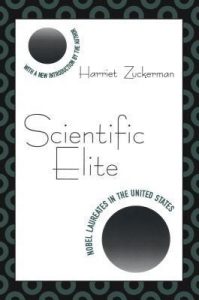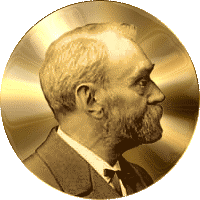 By Maria-Elizabeth Baeva, MSc student, Jefferies Lab
By Maria-Elizabeth Baeva, MSc student, Jefferies Lab
This is the fifth and final article in the Nobel Prize blog series.
Read the previous article: Nobel Prize Series Part 3: The Choice Between Acknowledgment and Atonement.
Why would someone want the Nobel Prize?
Beyond the pomp and circumstance of the ceremony and award, what happens after you win a Nobel Prize? In this last installment of the Nobel Prize series, we discuss the perks and problems that occur with winning this prestigious prize.
Despite winning the Nobel Prize in Literature in 1925, the purposefully controversial playwright George Bernard Shaw had some strong opinions about the prize itself, famously being quoted as saying:
“I can forgive Alfred Nobel for having invented dynamite, but only a fiend in human form could have invented the Nobel Prize.”
“Nobel prize money is a lifebelt thrown to a swimmer who has already reached the shore in safety.”
Interestingly, although he was not obligated to take the prize (there are cases of winners rejecting the award), he still accepted it. Now, this could be the result of simple hypocrisy, desire for fame or wealth, or simply Bernard Shaw’s propensity for being a provocateur. However, these acerbic musings do raise some valid questions.
Congratulations! Now what?

Harriet Zuckerman’s book “Scientific Elite”, which explores Nobel Prize winners and tracks the careers of all American laureates who won prizes from 1907 until 1972.
Some of the bonuses of winning this amazing award, as discussed by previous science Nobel Laureates, include opportunities for traveling, giving talks, being invited to lavish parties, meeting celebrities, and even being offered higher positions of power1.
This last benefit transitions us into deliberating the “hard perks” of winning the Nobel Prize, particularly in terms of scientific reputation and output. One of the most foundational studies on the subject came from Harriet Zuckerman in 1967. She performed a qualitative study interviewing 41 out of the 55 American science Nobel Laureates to better understand what makes a Nobel Laureate and what happens afterwards2. Since then, the phenomenon of the “Nobel dip” has since been described, wherein there is apparently a decrease in scientific output because of increased requests for speaking engagements and invitations to participate in international and esteemed functions. However, in recent years, more quantitative studies have come out with some interesting findings on the effects of winning a Nobel Prize, including:
- An increase in citations of the Laureate’s previous work3.
- While there is on average an 11.1% “dip” in average impact per paper 2 years after winning the prize, this effect is temporary and resumes at year 4 post prize4.
- While the number of new collaborators does not increase, the collaborators themselves have higher productivity and impact4.
- Laureates produce fewer papers but with higher average citations5.
- Laureates produce more solo-authored papers both before and after winning the Prize (this may be attributed to the fact that they write more reviews after winning)5.
- Amazingly, when matched to non-Laureate scientists from their country, Laureates live 1-2 years longer6.
But some effects have yet to be studied. While it is possible to make educated guesses or to assert that these following statements are “most likely true”, it is imperative that they are objectively studied. For example,
- Does Nobel-awarded work influence future research? Including allocation of funds from institutions and preferences of influential journals about what research is worth publishing.
- Does the prospect of the Nobel Prize alter research area trajectories on an individual scale? If your area of study is not “Nobel worthy”, does this cause a pivot towards something that is?
- Does the Nobel Prize influence how non-scientists view research? How popular is the view that scientific breakthroughs are achieved through individual “eureka” moments rather than slow, iterative, and collaborative work?
At this stage, we are just scratching the surface of the after-effects of the Nobel Prize. While the research thus far has focused on scientific output, there remains a vast gap in our understanding of the effects of the prize politically, mentally, sociologically, psychologically, and economically on not just the Laureates, but science and society as a whole.
A perpetual cycle
In my opinion, one of the most obvious and yet under-discussed consequences of the Nobel Prize has been the Matthew effect7, which has colloquially been simplified to “money begets money” or “the rich get richer and the poor get poorer”. In the context of the Nobel Prize, there is significant evidence that winners mentor and nominate other winners2,8. This would be unproblematic if these opportunities were equally accessible to all, but we know this is not the case. Given that political, gender, and national homophily, as well as academic reputation, play a role in the nominations of Laureates8, it becomes a perpetual cycle of a certain demographic of winners creating more winners of that same demographic.
To pick a single example to illustrate this point, the United States has seen a sharp increase in Nobel Laureates after World War II. Why? There are several reasons, but they can be broken down into:
- Hostility towards Germans after the war. This can be demonstrated by the number of German nominees, who, up until 1939, had 36 Nobel Laureates in sciences, compared to the US which had only 13. Between 1945-2020, the proportion of German nominees significantly dropped (54) while the number of American science laureates increased (277)*8,9.
- US gross domestic product had grown substantially during and after WWII, and thus investments increased into not only academic infrastructure and scientific technology but also in the recruitment of scientists10,11.
- Since WWII, UC Berkeley, Columbia University, and the Massachusetts Institute of Technology (MIT) have produced the most Nobel Laureates in the US12. Perhaps coincidentally, these universities are considered some of the richest in North America (#11, #12, and #6, respectively) and are thus more likely to be able to provide better facilities, equipment, training, and personnel for the up-and-coming scientist13.
While these statements are merely correlation at this time, it does point to an analytical framework that is often avoided when discussing the effects of the Prize. Speaking of which…
The lack of material analysis

Alfred Nobel set on a circular, gilt background
As previously mentioned, there is relatively little focus on how the finances of the winners and their associated institutions change after winning the Nobel Prize. And the amount won is nothing to sneeze at: as of 2020, each prize is worth $1,145,000 (US) and this amount has been increasing since the 1980s. This acute injection of wealth does not include the potential later financial gains from speaking appearances, increased grants awarded, universities/companies willing to hire you at an increased wage, and selling yourself based on your Nobel Laureate status (see the book by Peter Charles Doherty titled “The Beginner’s Guide to Winning the Nobel Prize: Advice for Young Scientists”).
It should be recognized that there are Laureates who donate some if not all their earnings to charity, including, but not limited to, Michael Smith, Günter Blobel, John Mather, and more. Others choose to spend their reward on new houses, their children’s education, sailboat upgrades, and other personal interests14. Individuals are free to spend their rewards how they see fit. However, as stated in a past Nobel Prize article, it is a dangerous game to rely on the good faith and charity of individuals to provide the financial resources necessary for the betterment of society.
With great power comes great responsibility
Focusing our attention away from the effects on the individual Laureate and the scientific institutions they belong to, our last topic of discussion will be the newfound power of the Laureates on the rest of the world. It is important to reinforce exactly how influential a Laureate is after they’ve won the prize: for better and for worse. And while most Laureates seem to be decent people who continue to work hard and advocate for science, some have used their recent power and privilege to cause harm.
While there are plenty of examples to choose from, I will focus on one: Kary Mullis. He was the co-winner of the 1993 Nobel Prize in Chemistry for his work in developing the polymerase chain reaction (PCR) technique (shared with Michael Smith for his work on site-directed mutagenesis). He was also an active conspiracy theorist who claimed that HIV was a hoax. Starting as early as 1995, twelve years after the discovery of the virus, he regularly gave talks and appeared in several documentaries about his belief that HIV was not real and did not cause AIDS16,17. By this point, many studies had come out confirming the link between HIV and AIDS. It is also important to note that he did not hide his Nobel Laureate status when he made such appearances.
What’s the solution to this? Do we make it so that the prize can be taken away? While this is a controversial opinion, I believe that there needs to be a dialogue about the moral responsibilities of Laureates after they win. While Mullis was lauded for his work on PCR, I am not the person who will explain to the family of a loved one who died of HIV-AIDS when they stopped treatment after seeing one of Mullis’ talks why he deserved to keep his prestigious title and wealth.
Conclusion
I’ve been thinking about the Nobel Prize for nearly a year. And while I may seem bitter and cynical about the whole process, I will admit that when I was in Stockholm, the Nobel Museum was one of my favorite parts of the trip. It is genuinely inspiring, and if a young student is inspired to work in science and discover the next miracle cure because of these inspirational figures, then that’s ultimately good. The history of the Nobel Prize does have some genuinely heartfelt and triumphant stories of perseverance, hard work, and creativity. But I think changes can be made to satisfy everyone. Let’s fix some of these issues so that the next 100 years of the Nobel Prize are even better than the last.
Acknowledgments
I would like to thank Kristine Ho and Michael Hughes for their tireless work of editing my pieces and for taking a chance on this big project.
*Only Nobel Prizes in Chemistry, Physiology and Medicine, and Physics are counted.
References
1 Landau, E. (2014, October 6th). How your life changes when you win a Nobel prize. New Scientist. Accessed February 6th 2021. https://www.newscientist.com/article/dn26326-how-your-life-changes-when-you-win-a-nobel-prize/
2 Zuckerman, H. (1967). Nobel Laureates in Science: Patterns of Productivity, Collaboration, and Authorship. American Sociological Review 32(3): 391-403. http://www.jstor.org/stable/2091086
3 Mazloumian, A et al. (2011). How Citation Boosts Promote Scientific Paradigm Shifts and Nobel Prizes. PLOS ONE 6(5): e18975. https://doi.org/10.1371/journal.pone.0018975
4 Li, J et al. (2020). Scientific elite revisited: patterns of productivity, collaboration, authorship and impact. Journal of the Royal Society Interface 17(165). https://doi.org/10.1098/rsif.2020.0135
5 Wagner, C.S. et al. (2015). Do Nobel Laureates Create Prize-Winning Networks? An Analysis of Collaborative Research in Physiology or Medicine. PLoS One 10(7): e0134164. doi: 10.1371/journal.pone.0134164
6 Rablen, M. D. and Oswald, A. J. (2008). Mortality and immortality: The Nobel Prize as an experiment into the effect of status upon longevity. Journal of Health Economics 27(6): 1462-1471. https://doi.org/10.1016/j.jhealeco.2008.06.001.
7 Wikipedia.org. Matthew Effect. Wikipedia. Accessed February 6th 2021. https://en.wikipedia.org/wiki/Matthew_effect
8 Gallotti, R. and De Domenico, M. (2019). Effects of homophily and academic reputation in the nomination and selection of Nobel laureates. Scientific Reports 9:17304. https://doi.org/10.1038/s41598-019-53657-6
9 Wikipedia.org. List of Nobel laureates by country. Wikipedia. Accessed February 6th 2021. https://en.wikipedia.org/wiki/List_of_Nobel_laureates_by_country
10 Lewis, D. (2016, November 16th). Why the U.S. Government Brought Nazi Scientists to America After World War II. Smithsonian Magazine. Accessed February 6th 2021. https://www.smithsonianmag.com/smart-news/why-us-government-brought-nazi-scientists-america-after-world-war-ii-180961110/
11 National Research Council. (1997). “Chapter 3- Science, Technology, and Innovation in the United States.” Maximizing U.S. Interests in Science and Technology Relations with Japan. Washington, DC: The National Academies Press. doi: 10.17226/5850.
12 Schlagberger, E.M., Bornmann, L. and Bauer, J. (2016). At what institutions did Nobel laureates do their prize-winning work? An analysis of biographical information on Nobel laureates from 1994 to 2014. Scientometrics 109: 723–767. https://doi.org/10.1007/s11192-016-2059-2
13 Barham, J. A. (2019, September 13th). The 100 Richest Universities: Their Generosity and Commitment to Research. The Best Schools. Accessed February 6th 2021. https://thebestschools.org/features/richest-universities-endowments-generosity-research/
14 Majumder, K. (2017, October 10th). Ever wondered how Nobel Laureates spend their prize money? Editage Insights. Accessed February 6th 2021. https://www.editage.com/insights/ever-wondered-how-nobel-laureates-spend-their-prize-money
15 Bufkin, K. (1995, April 17th). Scientist says HIV not cause of AIDS. Forty-Niner Online. Accessed February 6th 2021. https://web.csulb.edu/~d49er/Issue26/26nmullis.html
16 Internet Movie database. Kary B. Mullis. IMDB.com. Accessed February 6th 2021. https://www.imdb.com/name/nm2500077/?ref_=fn_al_nm_1


